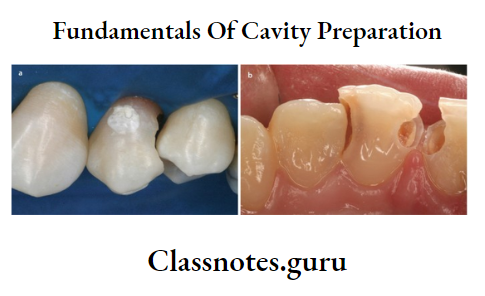Fundamentals Of Cavity Preparation Important Notes
1. Angles In The Cavity
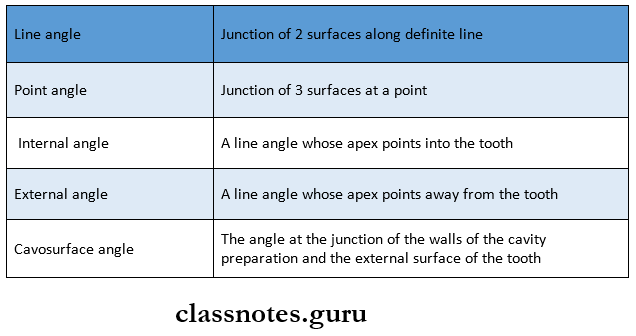
2. Walls In Cavity Preparation
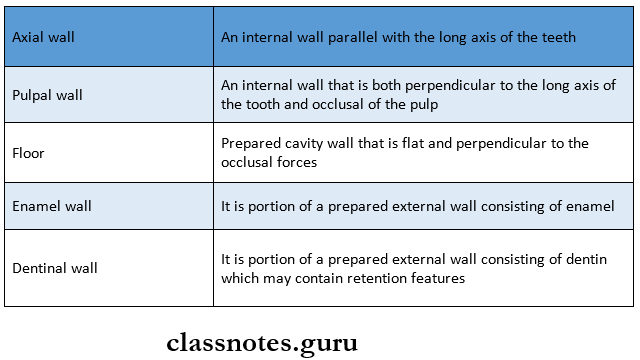
3. Steps In Cavity Preparation
- Initial Cavity Preparation
- Outline form
- Primary Retention form
- Secondary Resistance form
- Convenience form
- Final Cavity Preparation
- Removal of carious dentin
- Pulp protection
- Secondary retentive and resistance forms
- Finishing of external walls
- Cleaning, inspecting, and conditioning
4. Resistance Features
- Relatively flat floor
- Box shape
Read And Learn More: Operative Dentistry Short And Long Essay Question And Answers
- Preservation of cusps and marginal ridges
- Rounded internal and external line angles
- Cusp capping when indicated
5. Primary Retentive Forms
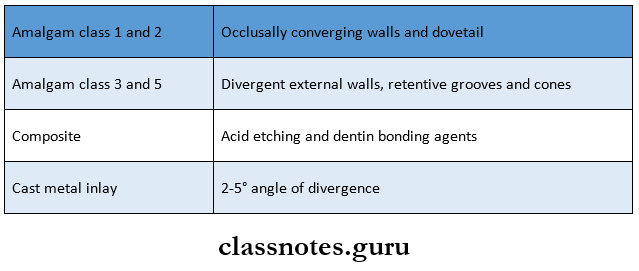
6. Secondary Retentive And Resistance Form
- Locks, pins, slots, steps and amalgam pins in amalgam provide secondary resistance and retentive forms
- Grooves, groove extensions, beveled enamel margins, and luting cement provide secondary retentive and resistance forms in cast metal restorations
7. Purpose Of Bevelling
- Produces stronger enamel wall
- Permits marginal seal in slightly undersized casting
- Provides marginal metal that is more easily burnished and adapted
- Assists in sealing gingival margins of castings that fail to seat by a very slight amount
Fundamentals Of Cavity Preparation Long Essays
Question 1. Enumerate steps in cavity preparation. Explain the outline form, retention form, and resistance form.
Answer:
Steps In Cavity Preparation:
- Initial cavity preparation
- Outline form
- Primary Retention form
- Secondary Resistance form
- Convenience form
- Final cavity preparation
- Removal of carious dentin
- Pulp protection
- Secondary retentive and resistance forms
- Finishing of external walls
- Cleaning, inspecting, and conditioning
Cavity Preparation Outline Form:
- Placing the preparation margins to the place they will occupy in the final tooth preparation
Cavity Preparation Factors:
- Extension of all carious lesions
- Caries index
- Old restorative material
- Initial depth 0.2-0.8 mm
- Aesthetics
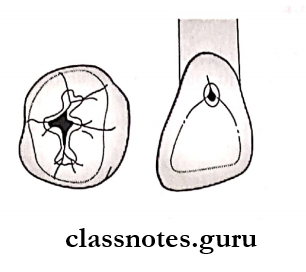
Cavity Preparation Features:
- Preserve cuspal strength
- Preserve marginal ridge
- Minimize extension
- Maintain initial depth to 0.2-0.8 mm
- Enameloplasty wherever required
Retention Form
- Retention Form is the form and shape of the cavity that resists the displacement of restoration from lifting and tipping forces
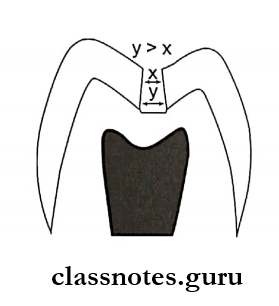

Retention Form Features:
- Occlusal convergence
- Dovetail
Resistance Form
- “Resistance Form is that shape and form of the cavity which enables both tooth and restoration to withstand without fracture the stresses of masticatory forces delivered principally along the long axis of the tooth”
Resistance Form Features:
- Box-shaped preparation
- Flat pulpal floor
- The adequate thickness of restorative material
- Preservation of marginal ridge
- Inclusion of weakened tooth structure
- Rounded internal line angles
- Cusp capping
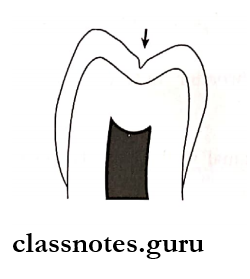
Fundamentals Of Cavity Preparation Short Essays
Question 1. G.V. Black’s classification of cavity preparation.
Answer:
G.V. Black’s Classification Of Cavity Preparation:

Fundamentals Of Cavity Preparation Short Answers
Question 1. Reverse bevel.
Answer:
Reverse Nevel:
- A reverse bevel is a bevel of generous width that is prepared on the facio margin of a reduced cusp with a flame-shaped, fine grit diamond instrument
- Its width should extend beyond any occlusal contact with opposing teeth
- Reverse Nevel should be at an angle that results in a 30-degree marginal metal
- The Reverse Nevel should be wide enough so that the cave surface margin is beyond any contact with the opposing dentition
Question 2. Reverse curve.
Answer:
Reverse Curve:
- Used in proximal preparation for class II amalgam restoration
- Indicated for broader contacts
Reverse Curve Features:
- Curving proximal walls inwards towards the contact area
Reverse Curve Importance:
- Useful as if excessive flare is given it results in weakening of tooth structure and fracture of restoration
Reverse Curve Advantages:
- Conserves tooth structure
- Preserves marginal ridge
- Increases resistance for tooth and restoration
Fundamentals Of Cavity Preparation Viva Voce
- GV Black simply classified cavities as one class of pit and fissure and four classes of smooth surface caries
- Cavities that occur exclusively in posterior teeth are class 2 cavities
- Cavities that occur both in anterior and posterior teeth are class 1 and 6
- A cavity preparation that includes both internal and external cavity walls is termed intracoronal preparation
- Enameloplasty is indicated when the fissure depth is not more than 1 /3rd the thickness of the enamel
- The class 5 cavity preparation is convex mesiodistally
- Cavities of the cusp tips of posterior teeth are class 6 cavities
- The axial wall is the base of class 3 preparation.
